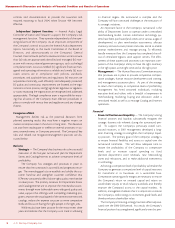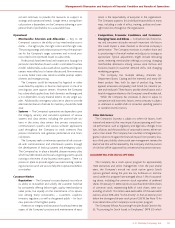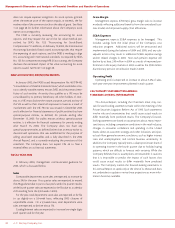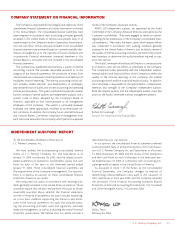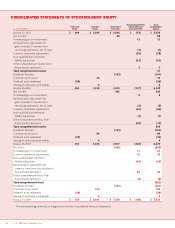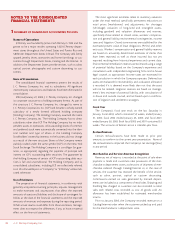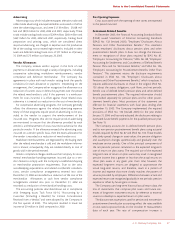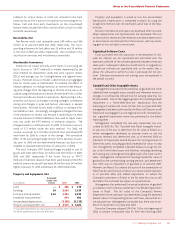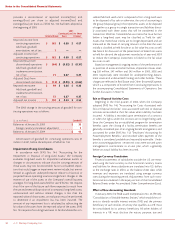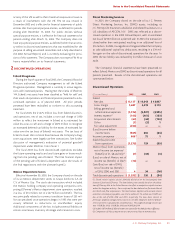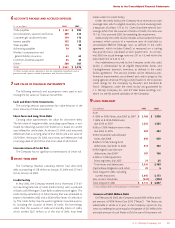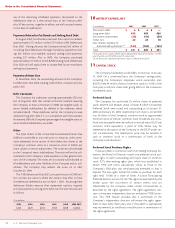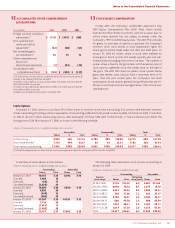JCPenney 2003 Annual Report Download - page 29
Download and view the complete annual report
Please find page 29 of the 2003 JCPenney annual report below. You can navigate through the pages in the report by either clicking on the pages listed below, or by using the keyword search tool below to find specific information within the annual report.
J. C. Penney Company, Inc. 27
Notes to the Consolidated Financial Statements
Advertising
Advertising costs, which include newspaper, television, radio and
other media advertising, are expensed either as incurred or the first
time the advertising occurs, and were $1,118 million, $1,028 mil-
lion and $893 million for 2003, 2002 and 2001, respectively. These
totals include catalog book costs of $264 million, $260 million and
$269 million for 2003, 2002 and 2001, respectively. Catalog book
preparation and printing costs, which are considered direct
response advertising, are charged to expense over the productive
life of the catalog, not to exceed eight months. Included in other
assets are deferred catalog book costs of $77 million as of January
31, 2004 and $73 million as of January 25, 2003.
Vendor Allowances
The Company receives vendor support in the form of cash
payments or allowances through a variety of programs, including
cooperative advertising, markdown reimbursements, vendor
compliance and defective merchandise. The Company has
agreements in place with each vendor setting forth the specific
conditions for each allowance or payment. Depending on the
arrangement, the Company either recognizes the allowance as a
reduction of current costs or defers the payment over the period
the related merchandise is sold. If the payment is a reimburse-
ment for costs incurred, it is offset against those related costs;
otherwise, it is treated as a reduction to the cost of merchandise.
For cooperative advertising programs, the Company generally
offsets the allowances against the related advertising expense.
Many of these programs require proof-of-advertising to be pro-
vided to the vendor to support the reimbursement of the
incurred cost. Programs that do not require proof-of-advertising
are monitored to ensure that the allowance provided by each
vendor is a reimbursement of costs incurred to advertise for that
particular vendor. If the allowance exceeds the advertising costs
incurred on a vendor specific basis, then the excess allowance for
the vendor is recorded as a reduction of merchandise cost.
Markdown reimbursements are negotiated by the buying team
after the related merchandise is sold and the markdown informa-
tion is known; consequently, they are credited directly to cost of
goods sold in the period received.
Vendor compliance charges reimburse the Company for incre-
mental merchandise handling expenses incurred due to a ven-
dor’s failure to comply with the Company’s established shipping
or merchandise preparation requirements. Due to the strict
recordkeeping requirements and related cost/benefit considera-
tions, vendor compliance arrangements entered into after
December 31, 2002 are recorded as a reduction of the cost of the
merchandise. Allowances or cash from vendor compliance
arrangements entered into prior to December 31, 2002 are
recorded as a reduction of merchandise handling costs.
The accounting policices described above are in compliance
with Emerging Issues Task Force 02-16, “Accounting by a
Customer (Including a Reseller) for Certain Consideration
Received from a Vendor,” and were adopted by the Company in
the first quarter of 2003. This adoption resulted in lower net
income of $9 million in 2003 compared to 2002.
Pre-Opening Expenses
Costs associated with the opening of new stores are expensed
in the period incurred.
Retirement-Related Benefits
In December 2003, the Financial Accounting Standards Board
(FASB) issued Statement of Financial Accounting Standards
(SFAS) No. 132 (revised 2003), “Employers’ Disclosures About
Pensions and Other Postretirement Benefits.” This statement
revises employers’ disclosures about pension plans and other
postretirement benefit plans. It does not change the measure-
ment or recognition of those plans required by SFAS No. 87,
“Employers’ Accounting for Pensions,” SFAS No. 88, “Employers’
Accounting for Settlements and Curtailments of Defined Benefit
Pension Plans and for Termination Benefits,” and SFAS No. 106,
“Employers’ Accounting for Postretirement Benefits Other Than
Pensions.” This statement retains the disclosure requirements
contained in SFAS No. 132, “Employers’ Disclosures about
Pensions and Other Postretirement Benefits,” which it replaces. It
requires additional disclosures to those in the original SFAS No.
132 about the assets, obligations, cash flows, and net periodic
benefit cost of defined benefit pension plans and other defined
benefit postretirement plans. The required information should
be provided separately for pension plans and for other postre-
tirement benefit plans. Most provisions of this statement are
effective for financial statements with fiscal years ending after
December 15, 2003. The Company implemented the required
provisions of SFAS No. 132 (revised 2003) for the year ended
January 31, 2004, and has early adopted the disclosures relating to
estimated future benefit payments for the qualified pension plan.
See Note 15.
The Company accounts for its defined benefit pension plans
and its non-pension postretirement benefit plans using actuarial
models required by SFAS No. 87 and SFAS No. 106. These models
effectively spread changes in asset values, the pension obligation
and assumption changes systematically and gradually over the
employee service periods. One of the principal components of
the net periodic pension calculation is the expected long-term
rate of return on plan assets. The required use of the expected
long-term rate of return on plan assets may result in recognized
pension income that is greater or less than the actual returns on
those plan assets in any given year. Over time, however, the
expected long-term returns are designed to approximate the
actual long-term returns, and therefore, result in a pattern of
income and expense that more closely matches the pattern of
services provided by employees. Differences between actual and
expected returns are recognized gradually in net periodic pension
expense or offset by future gains or losses.
The Company uses long-term historical actual return data, the
mix of investments that comprise plan assets and future esti-
mates of long-term investment returns by reference to external
sources to develop its expected return on plan assets.
The discount rate assumptions used for pension and non-pension
postretirement benefit plan accounting reflect the rates available
on AA-rated corporate bonds on the October 31 measurement
date of each year. The rate of compensation increase is



